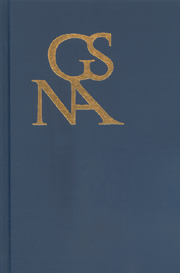Book contents
- Frontmatter
- Contents
- Towards a German Romantic Concept of the Ballad: Goethe's “Johanna Sebus” and Its Musical Interpretations by Zelter and Reichardt
- “Trübe” as the Source of New Color Formation in Goethe's Late Works Entoptische Farben (1817–20) and Chromatik (1822)
- The Myth of Otherness: Goethe on Presence
- The Transformation of the Law of Nations and the Reinvention of the Novella: Legal History and Literary Innovation from Boccaccio's Decameron to Goethe's Unterhaltungen deutscher Ausgewanderten
- “Hear him! hört ihn!”: Scholarly Lecturing in Berlin and the Popular Style of Karl Philipp Moritz
- Hypochondria, Onanism, and Reading in Goethe's Werther
- Judex! Blasphemy! and Posthumous Conversion: Schiller and (No) Religion
- Esoterik der “Macht, die über uns waltet und alles zum Besten lenkt”: Das Wissen vom Anderen in Goethes Wilhelm Meisters Lehrjahre
- Goethes Fortgepflanztes: Zur Unbegrifflichkeit der Morphologie
- Special Section on Die Entstehung der Neueren deutschen Literaturwissenschaft aus der Goethe-Philologie
- Book Reviews
Towards a German Romantic Concept of the Ballad: Goethe's “Johanna Sebus” and Its Musical Interpretations by Zelter and Reichardt
Published online by Cambridge University Press: 05 February 2013
- Frontmatter
- Contents
- Towards a German Romantic Concept of the Ballad: Goethe's “Johanna Sebus” and Its Musical Interpretations by Zelter and Reichardt
- “Trübe” as the Source of New Color Formation in Goethe's Late Works Entoptische Farben (1817–20) and Chromatik (1822)
- The Myth of Otherness: Goethe on Presence
- The Transformation of the Law of Nations and the Reinvention of the Novella: Legal History and Literary Innovation from Boccaccio's Decameron to Goethe's Unterhaltungen deutscher Ausgewanderten
- “Hear him! hört ihn!”: Scholarly Lecturing in Berlin and the Popular Style of Karl Philipp Moritz
- Hypochondria, Onanism, and Reading in Goethe's Werther
- Judex! Blasphemy! and Posthumous Conversion: Schiller and (No) Religion
- Esoterik der “Macht, die über uns waltet und alles zum Besten lenkt”: Das Wissen vom Anderen in Goethes Wilhelm Meisters Lehrjahre
- Goethes Fortgepflanztes: Zur Unbegrifflichkeit der Morphologie
- Special Section on Die Entstehung der Neueren deutschen Literaturwissenschaft aus der Goethe-Philologie
- Book Reviews
Summary
In the midst of the political turmoil of the Napoleonic wars, the force of nature took its toll on the French-occupied lower Rhine region. On January 13, 1809, the dam near Cleve (lying today in Germany near the Dutch border) collapsed, and the icy waters of the Rhine devastated the village of Brienen and flooded several other villages nearby. A seventeen-year-old village girl, Johanna Sebus, saved her mother's life but died herself trying to rescue her neighbors. Three months later, her body was found, and she was buried with honor near the old Gothic church in Rindern. Her selfless deed was not forgotten, which was especially due to the efforts of the magistrate of the Cleve district, Baron Charles de Keverberg, who brought the events to the attention of the French authorities. In 1811, a monument was erected to Johanna's memory. Designed by Dominique Vivant-Denon, whom Napoleon had appointed as first director of the Louvre Museum (at that time known as the Musée Napoléon), it is over three meters high, featuring a French text, and a marble medallion depicting a rose floating on the waves.
Johanna's death continues to be commemorated, most recently with an exhibition in Cleve on the 200th anniversary of her demise. Her courageous act has also inspired many painters, sculptors, and authors. The most famous and influential contribution was penned by Johann Wolfgang von Goethe, who honored Johanna with a ballad in May 1809.
- Type
- Chapter
- Information
- Goethe Yearbook 19 , pp. 1 - 28Publisher: Boydell & BrewerPrint publication year: 2012



